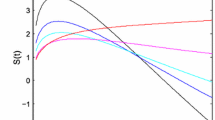Abstract
A mathematical characterization of the membrane potential as an instantaneous return process in the presence of refractoriness is investigated for diffusion models of single neuron’s activity. The statistical features of the random variable modeling the number of neuronal firings is analyzed by including the additional assumption of the existence of neuronal refractoriness. Asymptotic exact formulas for the multiple firing probabilities and for the expected number of produced firings are finally given.
Access this chapter
Tax calculation will be finalised at checkout
Purchases are for personal use only
Preview
Unable to display preview. Download preview PDF.
Similar content being viewed by others
References
Buonocore, A., Giorno, V., Nobile, A.G., Ricciardi, L.M.: Towards modeling refractoriness for single neuron’s activity. In Cybernetics mid Systems 2002 Vol. 1 (Trappl, R., ed.). Austrian Society for Cybernetics Studies, Vienna. (2002) 319–324
Buonocore, A., Giorno, V., Nobile, A.G., Ricciardi, L.M.: A neuronal modeling paradigm in the presence of refractoriness. BioSystcms 67 (2002) 35–43.
Feller, W.: The parabolic differential equations and the associated semi-groups of transformations. Ann. Math. 55 (1952) 468–518.
Gcrstcin, G.L., Mandelbrot, B.: Random walk models for the spike activity of a single neuron. Biophys. J. 4 (1964) 41–68.
Giorno, V., Lánský, P., Nobile, A.G., Ricciardi, L.M.: Diffusion approximation and first-passage-time problem for a model neuron. III. A birth-and-death process approach. Biol. Cybern. 58 (1988) 387–404.
Giorno, V., Nobile, A.G., Ricciardi, L.M.: On the asymptotic behavior of first-passage-time densities for one-dimensional diffusion processes and varying bound-aries. Adv. Appl. Prob. 22 (1990) 883–914.
Giorno, V., Nobile, A.G., Ricciardi, L.M.: Instantaneous return process and neuronal firings. In Cybernetics and Systems Research 1992 (Trappl, R., ed.). World Scientific (1992) 829–836.
Giorno, V., Nobile, A.G., Ricciardi, L.M.: On asymptotic behaviors of stochastic models for single neuron’s activity. In Cybernetics and System, 1996 (Trappl, R., cd.). Austrian Society for Cybernetic Studies (1996) 524–529.
Lánský, P., Smith, C.E.: The effect of a random initial value in neuronal first-passage-time models. Math. Biosci. 93 (1989) 191–215.
Ricciardi, L.M., Esposito, F.: On some distribution functions for non-linear switching elements with finite dead time. Kybernetik 3 (1966) 148–152.
Ricciardi, L.M., Di Crescenzo, A., Giorno, V., Nobile, A.G.: On the instantaneous return process for neuronal diffusion models. In Structure: from Physics to General System (Marinaro, M., Scarpctta, G., cds.). World Scientific (1992) 78–94.
Ricciardi, L.M., Di Crcsccnzo, A., Giorno, V., Nobile, A.G.: An outline of theoretical and algorithmic approaches to first passage time problems with applications to biological modeling. Math. Japonica 50 No. 2 (1999) 247–322.
Ricciardi, L.M., Lánský, P.: Diffusion models of neuron activity. In The Handbook of Brain Theory and Neural Networks (Arbib, M.A., cd.). The MIT Press, Cambridge (2002) 343–348.
Siegert, A.J.F.: On the first passage time probability problem. Phys. Rev. 81 (1951) 617–623.
Teich, M.C., Matin, L., Cantor, B.I.: Refractoriness in the maintained discharge of the cats retinal ganglion cell., J. Opt. Soc. Am. 68(3) (1978) 386–402.
Author information
Authors and Affiliations
Editor information
Editors and Affiliations
Rights and permissions
Copyright information
© 2003 Springer-Verlag Berlin Heidelberg
About this paper
Cite this paper
Ricciardi, L., Esposilo, G., Giorno, V., Valerio, C. (2003). Modeling Neuronal Firing in the Presence of Refractoriness. In: Mira, J., Álvarez, J.R. (eds) Computational Methods in Neural Modeling. IWANN 2003. Lecture Notes in Computer Science, vol 2686. Springer, Berlin, Heidelberg. https://doi.org/10.1007/3-540-44868-3_1
Download citation
DOI: https://doi.org/10.1007/3-540-44868-3_1
Published:
Publisher Name: Springer, Berlin, Heidelberg
Print ISBN: 978-3-540-40210-7
Online ISBN: 978-3-540-44868-6
eBook Packages: Springer Book Archive




